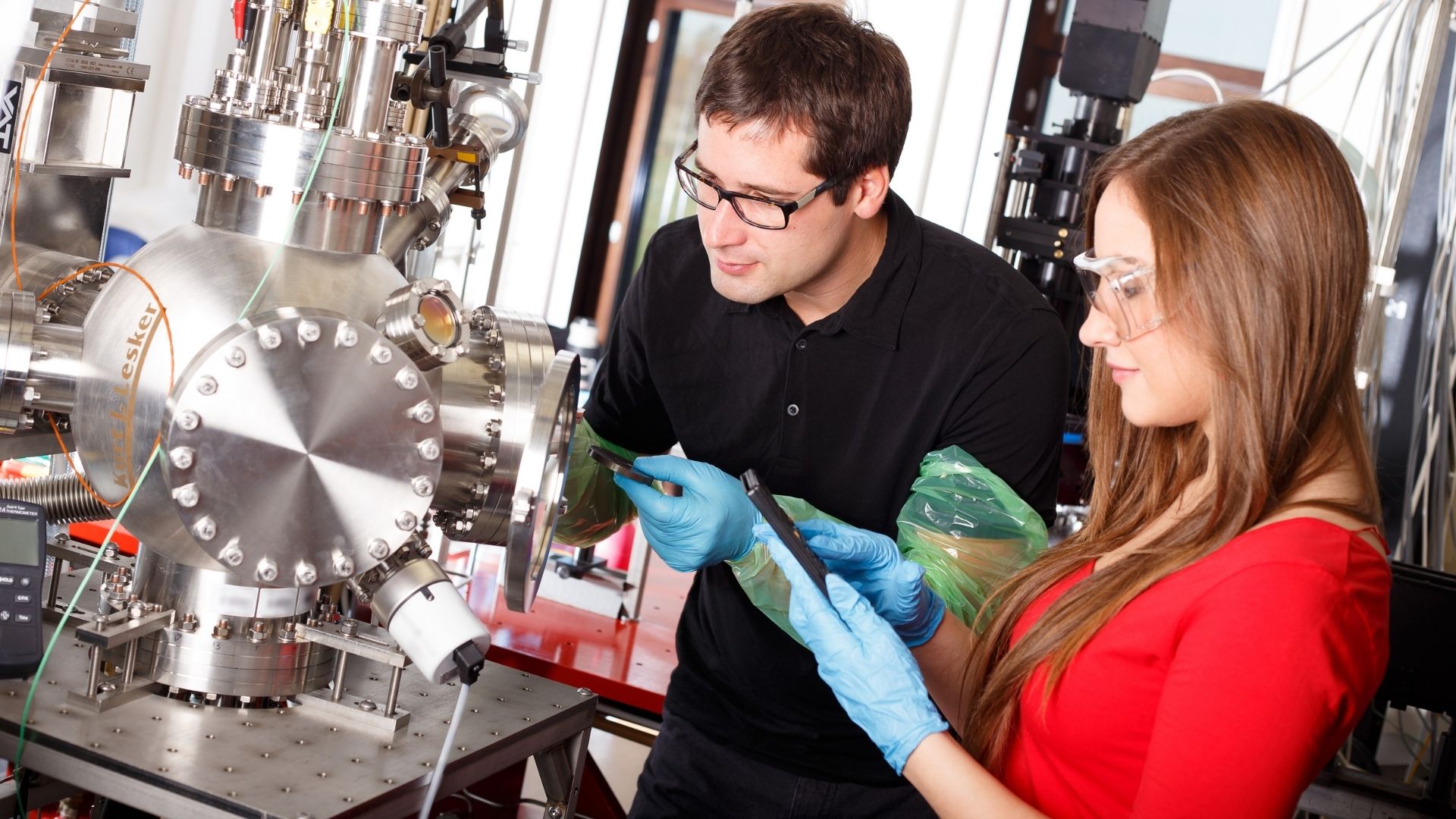20 Best Doctor of Physics Graduate Schools

Find your perfect college degree
Physics or physical science is a discipline that studies the elemental forces that govern every entity in the universe. Physical science is ubiquitous. It is concerned with electromagnetic energy, communication technologies, medical radiology and imaging, cosmological energy, astronomy, and biological physics.
While it is everywhere, not all of its forms and upshots are completely defined, described, or studied – yet this is where physics as an academic discipline thrives.
Academically, Physics is a degree for those with an unending inquisitive nature and an appreciation for abstract and intangible concepts. Waves, subatomic particles, and cosmology, to name a few, are concepts that only become alive and apparent through advanced mathematical equations.
The Doctor of Physics (Ph.D.) is a terminal degree in the field of physics. It is the most advanced degree available in the field of physics and provides students with the opportunity to explore a specialty area such as astrophysics, condensed matter physics, or quantum mechanics, among others.
Through coursework and research experience, Ph.D. students develop expertise in a chosen sub-discipline as they advance their understanding of physics. These levels of learning require not only extensive research experience but also extensive patience, as completion of dissertations and research may take years.
Most students who embark on an academic track in physics are geared to take it all the way to graduate school. A doctorate and post-doctorate in physics are the ultimate academic goals (not career goals). Upon completion, graduates of the Doctor of Physics program often pursue a career in research and academia.
Quick audio summary:
Check this out:
METHODOLOGY
The following metrics and considerations were employed to arrive at the ranking below (in no particular order):
- The number of available areas of focus/research areas, research centers, facilities, and institutions, and the availability of equipment and research instrumentation were strongly considered.
- Funding received from the National Sciences Foundation (NSF) and other government agencies, such as the Department of Energy, was also factored in, as this signifies the level and depth of scientific research activity within the institution.
- The availability of university-based and outside fellowships, grants, and awards was also considered, with the same rationale as with the previous metric.
- “Word of mouth” from other physicists themselves, through online scientific forums and other Q&A websites (e.g., Quora). Only responses from those with a legitimate profile with academic credentials to boot (Ph.D. or post-doc) were considered.
- Opportunities for interdisciplinary or collaborative research. It allows students to conduct applied physics work in other disciplines or industries, which is the ultimate goal of any theoretical work.
- Combination of rankings from other school ranking publications. The National Taiwan University – Performance Ranking of Scientific Papers for World Universities is also known as the NTU Rankings.
In summary, the ranking below was based on two things: breadth of research opportunities and professional public opinion. The first criterion is a given. The second criterion may appear subjective, but the reality is, that physicists determine the top caliber through published research in peer-reviewed journals and other scientific literature.
When on the hunt for a good physics program, you don’t ask a doctor, a lawyer, or an engineer, right? You ask a physicist.
THE 20 BEST DOCTOR OF GENERAL PHYSICS GRADUATE SCHOOLS
Yale University

New Haven, CT
Yale University was founded in 1701. The Physics Department was an upshot of the Department of Philosophy, the Arts, and the Sheffield Scientific School. In 1894, the Physics Department had physicist Arthur Day as part of its faculty.
- The Physics Ph.D. program requires students to complete the core courses in quantum mechanics, electromagnetic theory, and statistical and mathematical physics. First-year students must also take the following courses: Topics in Modern Physics Research and Responsible Conduct in Research for Physical Scientists.
- The prerequisites for doctoral candidacies, such as the required coursework, qualifying exams, and the submission of a written thesis proposal, should all be completed before the culmination of Year 3.
- Students can apply to any of the external fellowships that are available through the Physics Department. These include grants from the NSF and the Department of Energy.
Standout Features of the Program:
The department researches 11 areas of physics. Among the notable fields are Gravitational Physics and Biophysics. It is also home to three physics research centers, such as the Wright Laboratory and the Yale Quantum Institute. It offers an option for Physics Ph.D. students interested in interdisciplinary applied physics to cross-enroll into the Physical and Engineering Biology Ph.D. program, an inter-departmental offering.
Yale University was the first to confer a Ph.D. degree in the US in 1861. Also, among its many firsts, it is the first institution to confer higher learning degrees to minorities – first, to Yung Wing, a Chinese BA graduate in 1854, and Edward Bouchet, an African American Ph.D. graduate in 1876.
University of Washington (UW)

Seattle, WA
The University of Washington, a public research facility and university, was established in 1861. It has been teaching physics courses such as mechanics and calculus ever since. The Department of Physics was launched in 1928 and has since expanded to include a department dedicated to Astronomy and other research centers and institutes.
- UW offers a doctoral program in Physics, which requires the completion of 90 credits of coursework.
- A general exam is required, which determines the student’s readiness to undertake dissertation work. The final exam is also required, which is based on the doctoral candidate’s dissertation.
- Applicants to the program must demonstrate a strong background in courses like electromagnetism, quantum mechanics, and optics. Knowledge of nuclear, particle, and condensed matter physics is a big plus.
- Students can research any of the department’s 14 research areas, including Nuclear Theory and Neutrino Physics.
- First-year students are expected to take on mandatory teaching assistantship roles to receive funding. For the succeeding terms, students must secure funding sources on their own, whether through TA work, RA work, or a combination of both. UW will help in this regard.
Standout Features of the Program:
The department is home to six research centers and institutes, four of which receive government funding. For instance, the Department of Energy co-funds the Institute for Nuclear Theory along with university funding.
UW spearheads the NSF Institute for Accelerated AI Algorithms for Data-Driven Discovery or A3D3. It recently received a $15 million NSF grant to help fast-track studies in physics and astrophysics and integrate these with neuroscience through AI, data science, and machine learning. The institute brings together nine universities with UW at the helm.
California Institute of Technology (Caltech)

Pasadena, CA
Caltech was founded in 1891 by benefactor Amos Throop. In 1921, astronomer George Hale, physicist Robert Millikan, and chemist Arthur Noyes worked together to lead the university to become a behemoth in scientific research. Since then, Caltech’s Division of Physics, Mathematics, and Astronomy co-manages and spearheads more than ten research centers, including JPL, and has produced close to 20 Nobel laureates in Physics.
- Students admitted to the Ph.D. program in Physics must submit a study plan for approval before the first term closes.
- Passing the written exams (Year 2) and the oral exam (Year 3) is required.
- Completion of at least six advanced physics courses is also required. Students must choose three of the four areas below, from which the six courses will be taken:
- Elementary Particles and Fields
- Quantum Information and Matter
- Physics of the Universe
- Interdisciplinary Physics
- Students are also required to undertake TA work for at least one semester.
Standout Features of the Program:
There are 13 research areas within the Physics division. Some of the standout areas include Theoretical and Experimental Elementary Particle Physics and Gravitational Wave Science. Caltech is home to 7 research centers, including the Center for Data-Driven Discovery (CD3) and the Space Radiation Laboratory (SRL).
Caltech manages NASA’s Jet Propulsion Laboratory or JPL. Also, together with MIT, it operates the Laser Interferometer Gravitational-Wave Observatory, or LIGO, which the NSF funds. Caltech also owns the Palomar Observatory in San Diego, CA, and co-manages the Keck Observatory in Hawaii with the University of California system.
Harvard University

Cambridge, MA
Harvard University is one of the oldest US universities founded in 1636. In the 1800s, the Department of Physics was instituted, emphasizing integrating theoretical learning and laboratory application.
- The doctoral program in Physics, regardless of the chosen track, requires 64 credit units of study, passing marks in two oral examinations, and the submission and defense of a dissertation.
- Students may also cross-enroll at MIT for some graduate-level courses.
- Students are required to hold full-time academic residence for at least two years or four terms.
- Harvard will cover the cost of attendance, including stipends, of first-year Ph.D. students for both terms, after which students are expected to apply for fellowships or apply for RA positions or teaching fellowships to cover their funding and other expenses for the succeeding terms.
Standout Features of the Program:
The program offers four tracks toward a doctoral degree in Physics: General Physics, Biophysics, Engineering and Physical Biology (EPB), and Molecules, Cells, and Organisms (MCO). Students interested in doing physics research and its integration or application with other fields such as engineering and biology may opt for the other three tracks. Students under the general track may choose to join any of the department’s 13 research centers, including the Black Hole Initiative, the first of its kind worldwide.
The Department of Physics does its part to break stereotypes and glass ceilings through its “Women in Physics” initiative. The organization’s objective is to bring together female physics students of all levels of higher learning for mentoring and professional camaraderie. It also aims to encourage more women to be part of a career field that male scientists have long dominated.
Massachusetts Institute of Technology (MIT)

Cambridge, MA
Ph.D. in Physics and Ph.D. in Physics, Statistics and Data Science (PhysSDS)
Founded in 1861, MIT is a groundbreaker in research and its applications and, thus, home to many innovations. It launched the Department of Physics four years later, which offers the doctoral program via two pathways – General Physics and the Physics, Statistics and Data Science (PhysSDS) track.
- Both tracks can be completed in six years or less. Fewer attempts in doctoral exams can shorten the completion time.
- Students must research any of the following areas:
- Astrophysics
- Atomic and Optical Physics
- Biophysics
- Quantum Information
- Condensed Matter Physics
- Experimental OR Theoretical Nuclear and Particle
- Plasma Physics
- They must take at least two courses in their chosen area of research.
- Students in the Physics Ph.D. program may cross-enroll into the Ph.D. in PhysSDS track. They can complement their advanced physics research with knowledge of data science and analysis, inferential algorithms, and statistical modeling with machine learning, to name a few.
Standout Features of the Program:
MIT is proactive in helping its Ph.D. students, especially those in good standing, receive full funding throughout their residency, whether through fellowships, research assistantships (RA), or teaching assistantships (TA). For example, if the research contract for which the RA is completed or terminated, MIT will support the student for one term and proactively help seek other funding opportunities.
The MIT Physics faculty comprises achievers who have won almost every award and prize in Physics known to man – the Nobel Prize, the MacArthur Fellowship, the National Medal of Science, the Sloan Research Fellowships, the Presidential Medal of Freedom, and many more.
Princeton University

Princeton, New Jersey
In 1746, Princeton University became the fourth educational institution established in the US Princeton’s Physics research rose to prominence a century later thanks to Joseph Henry’s studies on electromagnetic induction.
- The Ph.D. program in Physics requires students to complete the required coursework within the first two years of study. A career development course, Communicating Physics, is also required.
- The preliminary exams must be taken within their first year of study. Some of the topics covered by the exam are quantum mechanics and thermodynamics.
- An experimental project must be presented before the culmination of Year 2. Students are strongly advised to begin preparations for this as early as their first term.
- Students can apply for any external fellowships, grants, and prizes to help fund their doctoral study and research. Travel funds are available for students partaking in other academic endeavors outside of Princeton.
Standout Features of the Program:
The department offers 11 research areas from which students can choose to conduct research. Some of the notable areas include Condensed Matter Experiment and Theory, High Energy Experiment and Theory, and Particle Phenomenology, to name a few. Princeton Physics is also home to 5 research centers. The NSF funded three of these, including the IRIS-HEP software center, which provides advanced information systems to the Large Hadron Collider at CERN.
Albert Einstein held an academic residency at Princeton, specifically at the Mathematics building, during the 1930s. He accepted an offer from the university’s Institute of Advanced Study as a researcher. Though he was not employed as a university faculty, he delivered lectures at Princeton and other American universities.
University of California – Santa Barbara

Santa Barbara, CA
Ph.D. in Physics and Ph.D. in Physics with Astrophysics Emphasis
After its incorporation into the UC system in 1936, not only did UCSB carry a new, but a new location as well, and this time, facing the sea with a two-mile-long shoreline. UCSB’s Department of Physics was launched in 1944 and continues to carry the reputation of being “relatively small” yet, a powerhouse in physics research and education.
- The department offers the Physics Ph.D. degree with two concentrations: the General Track and the Astrophysics track. Both tracks will require a candidacy exam and a dissertation defense for completion.
- Both tracks also require the completion of courses in Quantum Mechanics, Electromagnetic Theory, and Statistical Mechanics.
- Students under the General track are required to demonstrate knowledge of Lagrangian Mechanics. In contrast, those under the Astrophysics track must take any five of the following courses: Galactic Dynamics, Interstellar Medium, Extragalactic Astrophysics, Stellar Structure and Evolution, High Energy Astrophysics, and Cosmology.
- First and second-year students are guaranteed funding through TA or RA positions. There are five fellowships available through the department and many other opportunities through the UCSB Graduate Division.
Standout Features of the Program:
UCSB Physics researches eight areas of physics and houses and co-manages ten research centers, including Microsoft Station Q, which focuses on quantum physics. It is home to more than 20 research groups, including the Young Lab Group, helmed by Prof. Andrea Young. The group consists of post-doc, graduate, and undergraduate students and conducts studies on quantum materials through nanofabrication techniques and electronic measurement.
UCSB is the only educational and research institution in the US situated within walking distance of the beach. So, if you hit a snag in your research and feel burned out, remember that the sea is just right outside.
Stanford University

Stanford, CA
Stanford University was established in 1891, and the same year, the Department of Physics was also instituted. Research at the university first reached its peak during the 1930s, through prominent figures such as Felix Bloch, who discovered spin waves and was also Stanford’s first Nobel Prize recipient, for his collaborative work involving Nuclear Magnetic Resonance (NMR).
- Stanford’s doctoral program in Physics requires the completion of the following courses: Statistical Mechanics, Classical Electrodynamics, Research Activities at Stanford, and Teaching of Physics Seminar. A course on either Quantum Mechanics or Quantum Field Theory is also required.
- In addition, the following mathematics courses are also required: Complex Variable Functions, Linear Algebra and Matrix Theory, Complex Analysis, Partial Differential Equations, and Mathematical Methods.
- Students are also required to teach for at least three quarters to complete the Ph.D. program.
- First-year Ph.D. students are guaranteed funding through RA or TA work. Internal fellowships are available on a nomination basis. Students can also apply for the Knight-Hennesy Scholarship for graduate students and external fellowships, such as the NSF.
Standout Features of the Program:
The department has and continues to produce research in seven different areas of physics. Some of the department’s most applauded and popular research are the ones done on theoretical, observational, and experimental astrophysics and cosmology.
The Kavli Institute for Particle Astrophysics and Cosmology, or KIPAC, and the Stanford Linear Accelerator Center, or SLAC, were both established to deeply explore how the fundamental physical forces in the universe can be dissected, simulated, analyzed, and applied to other industries such as biotechnology, medicine, agriculture, geodetic science, and engineering, among many others. KIPAC is housed within SLAC, and the Department of Energy funds both entities.
University of Colorado – Boulder

Boulder, CO
The University of Colorado – Boulder (CU Boulder) is a publicly funded research institution belonging to the elite group of the American Association of Universities (AAU), along with 63 other universities. Established in 1876, CU Boulder has produced acclaimed research and innovations in the areas of bio-health, astrophysics, and sustainable energies, all of which are upshots of CU’s formidable physics programs and research.
- The CU Physics Department offers a doctoral program in Physics which requires the completion of 30 credit hours of graduate-level coursework.
- Students must maintain (at least) a 3.0 GPA to stay in the program.
- Students must complete two comprehensive exams and submit and defend a dissertation. The dissertation accounts for 30 credit hours.
- Ph.D. students can explore several funding options, from fellowships to RA or TA positions and award and research grant opportunities.
Standout Features of the Program:
Doctoral students can choose to research any of the 12 research areas available within the department. These include High Energy Physics, Astrophysics and Planetary Sciences, Plasma Physics, and Biophysics, to name. CU Physics is also home to various research centers and fellowships, such as the Joint Institute for Laboratory Astrophysics (JILA), the National Institute of Standards and Technology (NIST), and the Renewable and Sustainable Energy Institute (RASEI), among many others.
CU Physics offers other interdisciplinary Ph.D. programs such as Geophysics, Applied Physics, and Chemical Physics. The Applied Physics track has four concentrations: Biophysics, Imaging Sciences, Quantum Information Science, and Molecular Physics. Also, the department’s High Energy Physics faculty partook in the historical and collaborative Higgs boson particle discovery in Switzerland’s Large Hadron Collider, which goes to show the world-class caliber of the CU Physics faculty.
University of California – Berkeley

Berkeley, CA
In 1868, the University of California–Berkeley became the state’s first land-grant educational institution and the first school within the UC system. Berkeley’s Department of Physics pioneered high-energy physics research and, decades later, studied dark matter and neutrino science, as well.
- Berkeley’s doctoral degree in Physics is one of the most competitive in the world. Every year, more than 7000 applicants are considered by the department, but only 45 are accepted into the program, which amounts to a 6.4% acceptance rate.
- Ph.D. students must complete two written exams on Classical Physics and Modern Physics before applying for research fellowships.
- Students can choose from any of the seven research areas available at Berkeley Physics. Among these include Plasma and Non-linear Dynamics, Condensed Matter Physics, and Material Science, to name a few.
- Students can fund their studies through RA or TA work or by applying for any of the fellowships, scholarships, or awards offered by the department. Some of the fellowships are aimed at students involved in astrophysics or condensed matter physics studies.
Standout Features of the Program:
Students can also explore research opportunities in any of Berkeley Physics’ research centers that focus on the following areas: cosmological physics, theoretical physics, and nanoscience and engineering. Students interested in interdisciplinary and collaborative hands-on work can also explore opportunities at the Berkeley Lab and the Space Science Laboratory.
The department is home to the Physics R&D Machine Shop, a materials science and manufacturing haven for physicists. This shop can create and deliver parts for laboratory experiments, demonstrations, and other academic purposes, from metallurgical works like machining, milling, and assembly to computerized manufacturing, CAD/CAM, and 3D printing, this
The University of Chicago

Chicago, IL
Established in 1890, the University of Chicago operates for one purpose: research, or as Chancellor Robert Zimmer puts it, “inquiry.” The Physics Department, launched in 1893, was the true embodiment of this vision. The succeeding decades saw the department focus on experimental physics, emphasizing replicating previously successful experiments to hone students’ skills and prepare them for original research.
- The department’s Ph.D. program in Physics requires first-year students to complete an experimental physics requirement, either in the form of a course or a project.
- Students are advised to consult the department on the availability of courses as these may change from year to year. Some of the notable courses include Quantum Field Theory, Advanced Data Analysis, and Solid State Physics.
- Students can fund their studies through TA work or internal or external fellowships. The graduate school also offers a travel fund for academic activities outside Chicago, like conferences, lectures, or research.
Standout Features of the Program:
Chicago is home to ten research areas, which include Quantum Science and Nuclear Physics, among others. There are also ten research centers housed within the university, one of which is the Kavli Institute for Cosmological Physics (KICP). Chicago is also heavily involved in other research centers outside the university, such as Fermilab and CERN.
Chicago’s Physics Department is responsible for many discoveries such as the photon, the nuclear chain reaction, new isotopes, solar wind, and rotating black holes and their properties.
University of Arizona – Tucson

Tucson, AZ
Founded in 1885, the University of Arizona always played an important role in research, particularly space discoveries. From astronomer Gerard Kuiper’s Lunar Maps which aided the first moon landing in 1969 to the OSIRIS-Rex Asteroid study mission, UA consistently makes its mark as a viable and reputable institution for research and development.
- The Ph.D. in Physics program at UA requires the completion of at least 63 credit units, which includes 18 units from dissertation work.
- For the required coursework, including core courses in Analytical, Quantum, and Statistical Mechanics, and Electromagnetic Theory, a minimum GPA of 3.1 must be maintained.
- Students must take six elective courses. Choices include Molecular Biophysics, Plasma Physics, and Optical Physics, among others. Instead of this, an independent study requirement can be undertaken instead.
- UA offers a long list of internal and external fellowships to help students fund their studies. Specific external fellowships for doctoral candidates, women, minorities, and students with disabilities are also available.
Standout Features of the Program:
The department researches six areas of physics. Some notable areas include Optical Physics and Astrophysics. It is also home to three research facilities: the Biosphere 2, the Life and Planets Astrobiology Center (LAPLACE), and the NSF-funded Accelerator Mass Spectrometry Lab.
Students interested in Applied Physics and Medicine can also join the Master’s Program in Medical Physics. Some of the required coursework includes topics on radiation oncology physics and imaging physics. Completing the program, a combination of theoretical and applied learning prepares students for the American Board of Radiology certification. They are also eligible to apply to the medical residency program at the Department of Radiation Oncology.
Cornell University

Ithaca, New York
Cornell University was founded in Ithaca, New York, in 1865. In 1872, the university launched the Department of Physics thanks to physicist William Anthony. It conferred its first Ph.D. degree twenty years after the department’s inauguration. From the 1930s to 1940s, the department focused its research on nuclear physics. During the Space Race era, the department established the Laboratory of Atomic and Solid State Physics.
- To be considered, Ph.D. program applicants must have a solid background in quantum mechanics, optics, electronics, and advanced lab familiarity.
- The first two years of study should be spent on completing the required coursework, although preparatory steps to research work, e.g., reaching out to a prospective Ph.D. advisor, during this time are also encouraged.
- Although first-year Ph.D. students are guaranteed funding through TA work, it is strongly advised that they proactively seek funding opportunities through fellowships during their first year.
- Several fellowship opportunities are available which students can explore after their first year. One of which is the NSF Graduate Research Fellowship Program (GRFP) which accepts about 200 CGS students per year.
Standout Features of the Program:
Cornell Physics offers eight research areas, including Experimental Elementary Particle Physics, which students can focus on. The department is also home to nine research institutes that focus on particle physics, atomic physics, high energy physics, materials science, and nanoscience. One example is the Kavli Institute at Cornell (KIC) for Nanoscale Science, funded by the Kavli Institute.
During the 1940s, the Department of Physics welcomed to its faculty two famed physicists who were known for their participation in the Manhattan Project, Richard Feynman, who taught from 1945 to 1951, and Robert Wilson, who taught from 1947 to 1967.
University of Texas – Austin

Austin, TX
The University of Texas (UT) in Austin was established in 1883. The Department of Physics was launched a year later. Ten years later, the university’s first master’s degree in Physics was conferred to George W. Pierce. Pierce would later emerge as the pioneer of communications engineering technology.
- The UT Ph.D. in Physics program offers students flexibility in the curriculum, especially those who have already earned a master’s degree. Transfer credits are accepted.
- Instead of a written exam, oral qualifying exams, one via a panel and another via a one-on-one session, are implemented. The topic of the oral exam will center on the student’s dissertation proposal.
- A weekly “Pizza Seminar,” similar to a town hall session, with all faculty members present, is held to help students choose a dissertation topic. Pizza is served during the meetings, such as the name of the event. Students can also take the course Particle Physics: Introduction to Research instead of the weekly session.
- First-year students fund their studies through TA work but are encouraged to supplement this with a fellowship, scholarship, or grant, as well.
Standout Features of the Program:
The department is home to an extensive list of facilities and equipment to help students and researchers conduct investigations and experiments. The list includes a supercomputer, a cryogenic laboratory, various spectroscopical equipment, and many more.
The Department houses seven research centers and institutes focused on the different areas of physics such as quantum systems, gravitational physics, high energy physics, nonlinear dynamics, particle physics, and fusion studies.
Johns Hopkins University

Baltimore, MD
In 1876, Johns Hopkins University (JHU) was established as the first educational institution with a heightened focus on research. Every member of its faculty is involved in different studies and research, a tradition that continues today. Graduate students, especially those under the Department of Physics and Astronomy, are expected to be involved in original investigative work as early as their first semester.
- The department offers two Ph.D. programs – one in Physics and one in Astronomy.
- Students under the Physics track must take courses on electromagnetic theory, quantum mechanics, and advanced statistical mechanics.
- Students under both tracks are expected to take and pass the departmental exam before starting their second year of studies. They should also have an official thesis adviser by the end of their second year.
- Students must also maintain a grade of at least B- for every course.
- Most Ph.D. students at JHU receive full funding for at least five years through three common pathways: RA work, TA work, and fellowships.
Standout Features of the Program:
The department researches six areas of physics. Their work in Condensed Matter Physics is complemented by the department’s own Raman scattering machine housed at the Raman Laboratory.
JHU’s Department of Physics and Astronomy is well-equipped. Not only does it have its clean room, but it also has at least five furnaces, two magnetometers, various X-ray and spectroscopic equipment, and much more. It also has its machine shop, capable of designing and creating materials for investigations and experiments,
Purdue University

West Lafayette, IN
Established in 1862, Purdue University is a land-grant educational institution that used to be an A&M (agricultural and mechanical) college. Physics courses were taught at the university by 1874, but it wasn’t until 1904 that the discipline would have a department.
- The department offers two Ph.D. tracks, a Physics track, and an Astrophysics track.
- The Ph.D. in Physics program requires students to complete all necessary coursework within their first year.
- Various funding opportunities are available to students. Faculty members with open RA and TA positions are posted on the department’s website. Students must apply to external fellowships and grants/awards for augmented funding.
- Students in both physics and astrophysics tracks can specialize in computational science and engineering (CSE) on top of their doctoral studies. Some of the courses prescribed in the CSE curriculum include Scientific Visualization, Statistical Machine Learning, AI, and Optimization Methods for Systems and Control, among many others.
Standout Features of the Program:
Purdue Physics conducts studies in ten research areas. Some of the notable and distinct focus areas include Planetary Physics and Geophysics, and Quantum Information Science. The department also holds regular seminars in these focus areas.
Purdue Physics collaborates with other departments and the university’s other research institutes located in the “Discovery Park” area campus. For biophysics, there is the Bindley Bioscience Center. For nanoscience, there is the Birck Nanotechnology Center. For particle and accelerator physics, there is the Purdue Rare Isotope Measurement Laboratory or the PRIME Lab. And for quantum physics and atomic and molecular optics (AMO), there is the Purdue Quantum Science and Engineering Institute.
Georgia Institute of Technology

Atlanta, Georgia
Established in 1885, Georgia Tech was originally a trade school with a focus on engineering. Its transformation to a research university mirrored the state’s transformation from agrarian and skilled-trade roots to an industrial hub driven by research and development. While physics has long been taught at the university, it wasn’t until 1938 that the discipline would have its own home.
- The Ph.D. in Physics program requires the completion of the required coursework and passing the candidacy exam before the doctoral research or dissertation.
- Students are also required to undertake seminars and complete specialized problem sets.
- Ph.D. students who are in good standing are guaranteed funding that covers tuition and health insurance, at the very least.
- Students also can cross-enroll in other interdisciplinary doctoral programs such as the Quantitative Biosciences Ph.D. program or the Computational Science and Engineering (CSE) Ph.D. program. Students must consult their advisers on how to streamline their curriculum to avoid redundant courses. A master’s degree in Robotics is also available as a top-up degree option.
Standout Features of the Program:
Georgia Tech has six physics areas for research work. Some notable areas of focus include Non-linear Physics, Astroparticles, and Soft Matter Physics, to name a few. The department also houses two research centers: the Center for Non-linear Science and the Center for Relativistic Astrophysics (CRA).
In collaboration with UC Santa Barbara, Georgia Tech is currently doing groundbreaking – literally – investigations on the subterranean landscape, using a robot that can burrow through soft ground, like sand, for example. This is an interdisciplinary research endeavor co-founded by several government agencies like the NSF, NASA, and the Army Research Office.
University of Illinois – Urbana-Champaign (UIUC)

Urbana, IL
The University of Illinois is a research and academic hub founded in 1867. It is known to spearhead groundbreaking research such as digital education with PLATO, LED technology, Magnetic Resonance Imaging, or MRI, which is the pride of UIUC’s Department of Physics. Its doctoral offering requires the completion of 96 credit units, including individual research and a dissertation.
- Students can choose from any of the department’s eight research areas, which include Nuclear Physics, High Energy Physics, and Condensed Matter Physics, to name a few.
- Students are also strongly encouraged to take courses on Quantum Mechanics, Mathematical Methods, Statistical Physics, and Classical Electromagnetism in preparation for research work.
- The program has seven core courses, and students are required to take two from any of these:
- Theoretical Astrophysics
- Biomolecular Physics
- Condensed Matter Physics
- Emergent States of Matter
- Subatomic Physics
- Quantum Optics and Information
- Modern Atomic Physics
- Examinations are required before undertaking research work for dissertation submission and defense.
Standout Features of the Program:
This is one of the top 20 doctoral physics programs in the US, according to Clarivate Analytics, currently ranking 15th (24th best in the world). The department receives close to $30 million in funding annually from the NSF and other benefactors.
The department is home to thirteen Nobel Prize laureates. In 2003, it took home two prizes – one for Physics, through Dr. Anthony J. Leggett’s research on superconductors and super-fluids, and the other for Medicine, through Sir Peter Manfield’s discovery of MRI and its use in Medicine.
Columbia University

New York, NY
Columbia University is New York’s oldest university, founded in 1754. It is also the fifth university to be instituted in the US. More than a hundred years later, the Department of Physics was established. The Pupin Hall, which houses the department and the Pupin Laboratory, was named after long-serving department chair, physicist Michael Pupin. He spearheaded the development of a cyclotron which was instrumental to the Manhattan Project research of the 1940s.
- The department offers three graduate degrees in Physics – an MA, an M.Phil., and a Ph.D. This contrasts with other universities that only offer a Ph.D. program in Physics, with the MA as an in-progress conferment.
- The department requires students to have earned an MA and then an M.Phil. in Physics, which equals three years of study. During this time, students would need to complete 30 credits of coursework in preparation for the doctoral qualifying exams and research.
- The qualifying exam is divided into four parts: Classical Physics, Modern Physics, General Physics, and an Oral Exam.
- During the first two years in graduate school, funding can come from teaching laboratory classes and supervising problem sets. Students can also explore other sources of funding like fellowships and awards.
Standout Features of the Program:
The department conducts research in different interdisciplinary areas of physics such as Biology, High Energy Nuclear and Particle Physics, Molecular and Atomic Physics, Astrophysics, Gravitational Waves, and Cosmology, to name some.
Aside from Columbia’s pivotal role in the Manhattan Project (the isolation of Uranium isotope 235, elemental to the atomic bomb creation), the university also saw the establishment of the American Physical Society.
University of Pennsylvania

Philadelphia, PA
The University of Pennsylvania is one of America’s oldest universities. Founded in 1740, this Ivy League school has always been known for its top-caliber faculty and graduates. Its Department of Physics and Astronomy is one of the smallest heads, but its heightened focus and successful discoveries in key physics areas make its mark on the world stage.
- The Ph.D. program in Physics requires the completion of 20 credit units (each course equals one credit). Courses on statistical, mathematical, and quantum mechanics and electromagnetism are all required. For these core courses, a minimum grade of B+ must be maintained.
- Upon completing the core courses, the oral candidacy exam must be undertaken as soon as possible, or at most, 18 months after passing the courses.
- Students are encouraged to conduct original interdisciplinary research for their dissertations to compel them to collaborate with scholars from other departments.
- Internal and external fellowships are available to help students with funding.
Standout Features of the Program:
The department categorizes its research areas into three main topics:
- Condensed Matter, which includes subtopics like soft and living matter, and biophysics,
- Astronomy, which includes subtopics like dark matter and dark energy, and,
- Particle Physics involves collaborative work in high-energy physics, neutrino physics, String theory, and cosmology.
UPenn’s work in Particle Physics features collaborations with renowned research centers that have resulted in groundbreaking physics discoveries. Some of these include:
- The unearthing of the neutrino mass through research conducted at the Sudbury Neutrino Observatory (SNO),
- Experiments at the Large Hadron Collider resulted in the discovery of the Higgs boson,
- Detection of the top quark through the joint effort of the UPenn and Fermilab teams.

FREQUENTLY ASKED QUESTIONS
What is a Doctor of General Physics graduate program?
A Doctor of General Physics graduate program or a Ph.D. program in Physics is a research program that requires students to take a few core courses in preparation for dissertation work. Compared to undergraduate or master’s degrees, which usually culminate with a choice between a capstone project, a thesis, or a practicum, a doctoral or Ph.D. program, especially in Physics, will always culminate with a dissertation proposal, and then, the public defense.
Most doctoral programs in Physics accept students straight out of the undergraduate level, which would seem like the doctoral program is a twofer – a master’s and a Ph.D. program rolled into one, which it is. However, applicants must remember that most of these programs only confer the master’s degree in Physics once the student’s dissertation has been accepted by the department, meaning the student is moving on into the actual doctoral phase of the program, which is now all about the execution of the accepted dissertation topic.
A terminal master’s degree in Physics is rarely available, and Physics schools rarely accept applicants who only intend to earn a master’s degree.
What are the benefits of a General Physics doctorate?
A doctorate in Physics pays well. BLS reports that in 2022, physicists with a Ph.D. earn a median salary of close to $140K annually. Most physicists are employed by private and government-funded research institutes or centers, and normally, the entry-level requirement is a bachelor’s degree in physics or a related field.
But, undergrads will only land assistantship roles unless they apply to a graduate program. Published and acclaimed research increases a physicist’s marketability to join a renowned research facility or group, especially at the graduate level.

Who can apply to the program?
Most Physics Ph.D. programs will accept students with a bachelor’s degree in Physics or a related degree. Otherwise, students can still be accepted into programs provided they can demonstrate competency in the following core physics courses: quantum mechanics, electromagnetic theory, statistical mechanics, and mathematical physics. College graduates with a strong background in advanced mathematics, computational science, and engineering may also be a good fit for such a program.
Are GRE scores required? What are the other admission requirements?
GRE scores, as of writing, are optional, with some universities not requiring it at all. But make sure to check with the department’s admission office to confirm as GRE policies may change.
Other requirements are the usual ones required by graduate schools, such as letters of application, transcripts, essays, letters of recommendation, and a CV.
What are the usual degree requirements?
Accepted grad school entrants who still have to earn their master’s degree must complete a specific number of coursework credits. These need to be completed during the first two years of study. Some rigorous programs are more stringent, requiring students to complete the coursework within the first year, with an added requirement of independent research, to be presented and defended by the end of the second year of study.
A candidacy exam, which is usually oral, sometimes written, or a combination of both is required of students after completing the required coursework and before (or simultaneous with) the presentation of a dissertation proposal. This exam gauges the student’s core competency and readiness for doctoral research.
Once the committee has accepted the dissertation, which is usually in year 5 or 6, some programs require students to take another exam, usually an oral exam, synonymous with the dissertation defense. Once passed, the degree of Doctor of Philosophy in Physics can be awarded to the student.
How long does getting a Doctorate in Physics take, and is it worth the time and money?
Getting a Doctorate in Physics typically takes 3 to 5 years (or possibly more) of study and research. It is worth the time and money if you are looking to pursue a career in academia, research, or the technical industry.
In addition to increased job options, people with a doctorate usually have higher salaries and an edge in the job market. On the other hand, if you are looking to pursue a career in a different field, a Doctorate in Physics may not necessarily be the best investment.




